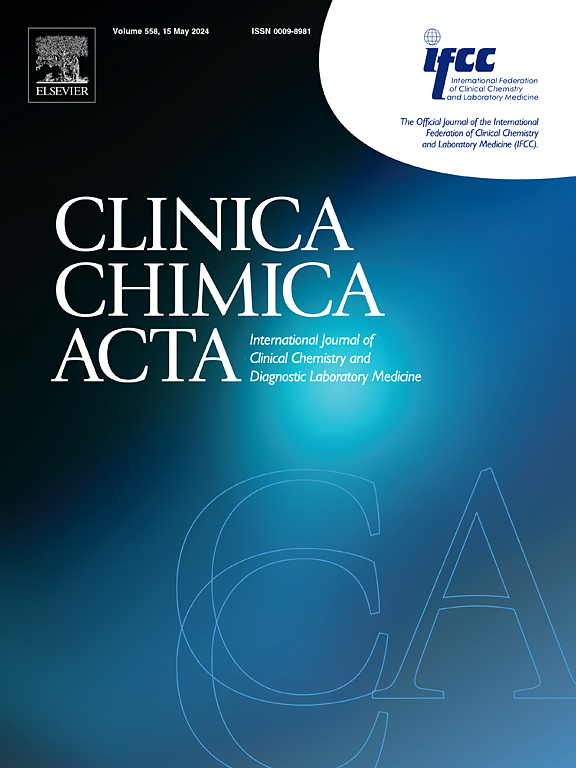对1600名无精子症和严重少精子症不育患者的回顾性分析。
IF 3.2
3区 医学
Q2 MEDICAL LABORATORY TECHNOLOGY
引用次数: 0
摘要
研究目的本研究旨在探讨男性不育症患者的遗传病因:共有 1600 名男性不育症患者接受了精液常规分析、染色体核型分析和性激素水平检测,其中包括 1300 例无精子症患者和 300 例严重少精子症患者。采用多重荧光定量 PCR 技术检测了 Y 染色体上的无精子症因子(AZF)。此外,还对染色体核型和无精子症因子正常的纯绒毛膜细胞综合征患者进行了拷贝数变异(CNV)分析:结果:在 1600 名男性不育患者中,有 334 例(20.88%)发现染色体异常。最常见的异常类型是性染色体异常(18.94%),其中 47、XXY 是最常见的异常核型。无精子症组和严重少精子症组的染色体异常率有显著差异(分别为 23.69% 和 8.67%;PC 结论:男性不育是一种复杂的多因素疾病,染色体异常和Y染色体微缺失是导致该病的重要遗传因素。不育男性的初始基因检测应包括核型和 Y 染色体微缺失。如有必要,应进行 CNV 检测,以确定临床诊断,并为男性不育症提供个体化治疗。本文章由计算机程序翻译,如有差异,请以英文原文为准。
A retrospective analysis of 1600 infertility patients with azoospermia and severe oligozoospermia
Objective
This study aimed to investigate the genetic etiology of male infertility patients.
Method
A total of 1600 male patients with infertility, including 1300 cases of azoospermia and 300 cases of severe oligozoospermia, underwent routine semen analysis, chromosomal karyotype analysis and sex hormone level testing. The Azoospermia factor (AZF) on the Y chromosome was detected using the multiple fluorescence quantitative PCR technique. Additionally, copy number variation (CNV) analysis was performed on patients with Sertoli-cell-only syndrome who had a normal karyotype and AZF.
Result
Chromosomal abnormalities were found in 334 cases (20.88 %) of the 1600 male infertility patients. The most common type of abnormality was sex chromosome abnormalities (18.94 %), with 47, XXY being the most frequent abnormal karyotype. The rates of chromosomal abnormalities were significantly different between the azoospermia group and the severe oligospermia group (23.69 % and 8.67 %, respectively; P<0.05). AZF microdeletions were detected in 155 cases (9.69 %), with various deletion types and AZFc region microdeletion being the most prevalent. The rates of AZF microdeletions were not significantly different between the azoospermia group and the severe oligospermia group (9.15 % and 12 %, respectively; P=0.133). In 92 patients with Sertoli-cell-only syndrome who had a normal karyotype and AZF, the detection rate of CNV was 16.3 %. Compared to the severe oligospermia group, the azoospermia group had higher levels of FSH and LH and lower levels of T and E2, and the differences were statistically significant (P<0.05).
Conclusions
Male infertility is a complex multifactorial disease, with chromosomal abnormalities and Y chromosome microdeletions being important genetic factors leading to the disease. Initial genetic testing of infertile men should include karyotyping and Y chromosome microdeletions. If necessary, CNV testing should be performed to establish a clinical diagnosis and provide individualized treatment for male infertility.
求助全文
通过发布文献求助,成功后即可免费获取论文全文。
去求助
来源期刊

Clinica Chimica Acta
医学-医学实验技术
CiteScore
10.10
自引率
2.00%
发文量
1268
审稿时长
23 days
期刊介绍:
The Official Journal of the International Federation of Clinical Chemistry and Laboratory Medicine (IFCC)
Clinica Chimica Acta is a high-quality journal which publishes original Research Communications in the field of clinical chemistry and laboratory medicine, defined as the diagnostic application of chemistry, biochemistry, immunochemistry, biochemical aspects of hematology, toxicology, and molecular biology to the study of human disease in body fluids and cells.
The objective of the journal is to publish novel information leading to a better understanding of biological mechanisms of human diseases, their prevention, diagnosis, and patient management. Reports of an applied clinical character are also welcome. Papers concerned with normal metabolic processes or with constituents of normal cells or body fluids, such as reports of experimental or clinical studies in animals, are only considered when they are clearly and directly relevant to human disease. Evaluation of commercial products have a low priority for publication, unless they are novel or represent a technological breakthrough. Studies dealing with effects of drugs and natural products and studies dealing with the redox status in various diseases are not within the journal''s scope. Development and evaluation of novel analytical methodologies where applicable to diagnostic clinical chemistry and laboratory medicine, including point-of-care testing, and topics on laboratory management and informatics will also be considered. Studies focused on emerging diagnostic technologies and (big) data analysis procedures including digitalization, mobile Health, and artificial Intelligence applied to Laboratory Medicine are also of interest.
 求助内容:
求助内容: 应助结果提醒方式:
应助结果提醒方式:


